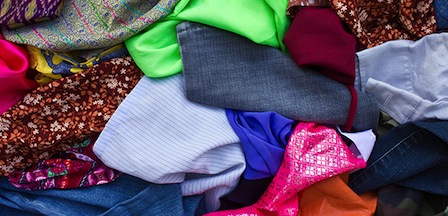Published on

The textile industry and ready-to-wear clothing bring many things to mind: trends, vogues, fashionistas, styles, wardrobes and accessories, for some. For others, they raise questions about precarious working conditions, lack of financial security, polluting production processes and impacts on the environment and health, amongst other things.
Without wanting to demonize the need for clothing, we have to acknowledge that behind that basic T-shirt lies an increasingly worrying situation. And we see it in the news: the birth of the movement against sweatshops in the nineties, the collapse of a garment factory in Bangladesh and the recent reality TV show “Sweatshop”.
However, the ready-to-wear industry also offers certifications that, in some cases, guarantee organic production methods and ethical and worker friendly practices. They also promote the development of new textiles, like hemp, with a small environmental footprint, the innovations of local designers, the development of workers’ cooperatives, and more.
We can all help limit the damage. We can all be more responsible and practise the 4R philosophy: reduce, reuse, recycle and reclaim.
The first step is to use less, and better. As Équiterre’s guide to eco-friendly clothing clearly states, one less purchase is better than an eco-friendly one. It also provides a wealth of information on how to make the best choices.
How to go about it
Reduce
Reducing is about buying less. Stop and think before buying the latest must-have top and ask yourself, “Do I really need this?” Most of the time, the answer is no!
Reuse
Reusing involves using something for purposes other than those initially intended. It also means keeping clothes for longer!
Then, when they’ve reached the end of their life cycle, you can give them a fresh new look with eco-friendly dyes, by customizing them with textile decorations or by making them into something else—like turning a pair of pants into shorts.
Thrift stores are full of used clothes and are an excellent way of giving new life to clothes you no longer want. If you’d like to buy second-hand or give clothing, check out these lists: http://www.arrondissement.com/tout/c704-friperie/ http://www.ecoquartier.ca/index.php/mode-ecolo-et-equitable.html
At a swap with friends and coworkers, you could trade that too-small girl’s dress for a newborn’s romper. It’s easy to organize and it’s fun! But if you’re not an organizer at heart and you’d like to attend a swap, why not go to the next TROC-tes-TRUCS?
Recycle
Recycling may seem trivial, but creating a new object involves a whole transformation process. Instead of throwing away your clothes, think about giving them away. All in all, recycling is very energy intensive. You can take used clothing to a number of Quebec organizations that are listed here!
Textiles are easily recycled. Shredded fabric from old synthetic clothing is made into new clothes. Many companies and designers are increasingly offering products made from recycled fibres. Check the labels!
Reclaim
Reclaiming is about giving new life to things!
Old clothes make great cleaning cloths and an unworn sweater at the back of the closet could be the centrepiece for a patchwork blanket. You can explore websites like Pinterest for all sorts of creative ideas.
Most eco designers will be delighted to receive your fabric scraps—it’s their raw material! They’ll use them to make unique new creations. You’ll find the best places here.
Please remember that, however committed you are to the 4 Rs, every little bit counts!
For more information
Certex Textile Recovery and Sorting Centre
Eco-district Ahuntsic-Cartierville’s ethical, eco-friendly and fair-trade fashion directory




